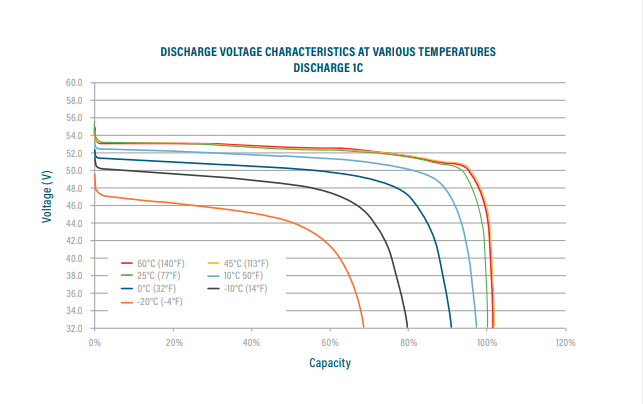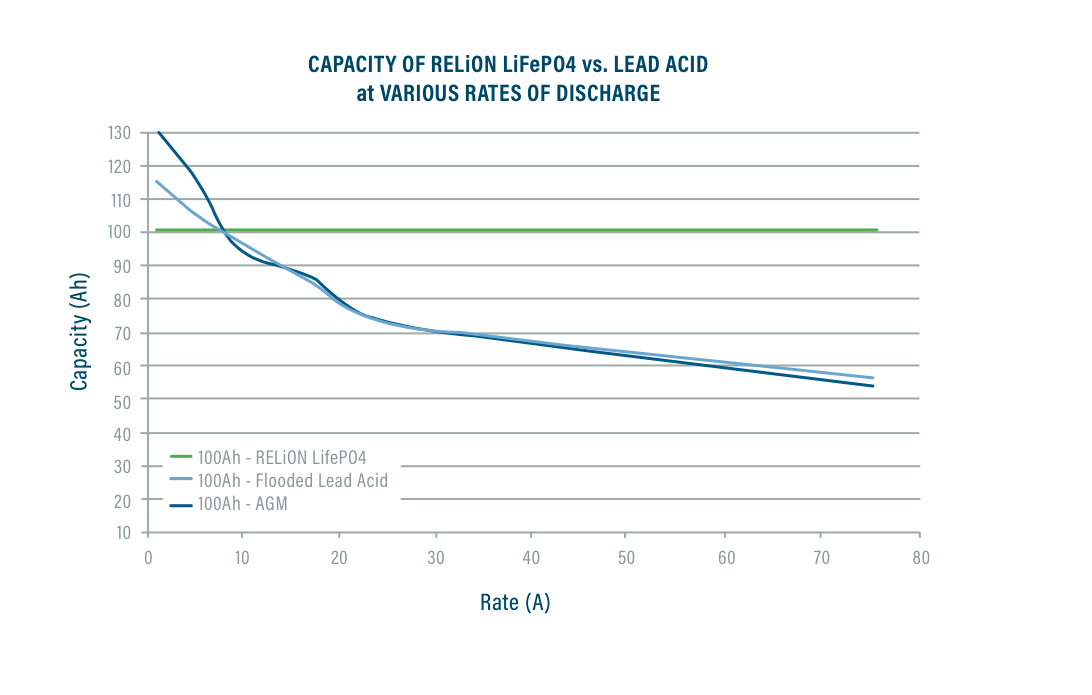Features
Partial State of Charge Tolerant
Partial state of charge, known as PSOC, which is a killer of lead-acid batteries, does not affect performance or battery life of a lithium battery. Sometimes batteries don’t get fully charged, or they regularly operate in a partial state of charge. Either way, you can count on RELiON lithium batteries living a long and productive life.
Maintenance Free
Plug, play, and charge. No watering, no corrosion.
Eco-Friendly & Safe
RELiON lithium batteries are the ultimate clean energy. No gassing, no fumes, and no pollution. Enjoy reliable power, while protecting the environment, using these non-hazardous batteries.
More Usable Capacity
Lead-acid batteries are typically sized up to two times your energy needs to account for extended periods without sun and less usable energy with higher rates of discharge. Plus, you are typically cautioned to limit your use to 50% of the rated capacity, as using more can significantly reduce performance. Lithium batteries provide 100% of their rated capacity, regardless of the rate of discharge. And, you can use it all and still get substantially longer cycle life.
Highly Efficient
RELiON lithium batteries have super low resistance, allowing you to charge much faster. And lithium batteries are 99% efficient, minimizing the losses during charge. Compare that to traditional lead-acid batteries at 75-80% efficiency, which results in significant loss when recharging.
Long Life
RELiON lithium batteries provide up to 10 times longer life than lead-acid batteries, and they still provide 80% of the rated capacity after 3,500 cycles.
Fast Charging
RELiON lithium batteries charge much faster than traditional lead-acid batteries, and they’re packed with more usable energy and up to 10 times longer life so you’re always ready to go!
Constant Power
Full power available throughout discharge. Voltage does not drop like lead-acid.
Specifications
Electrical Specifications |
|
|---|---|
| Nominal Voltage | 51.2 V |
| Nominal Capacity | 200 Ah |
| Capacity @ 25 A | 480 min |
| Energy | 10.24 kWh |
| Resistance | 50 mΩ @ 50% SOC |
| Efficiency | 99% |
| Self Discharge | <3% per Month |
| Maximum Batteries Connected in Series | 1 (Single Use) |
Mechanical Specifications |
|
|---|---|
| Dimensions (L x W x H) | 34.3 x 14.2 x 15.6” (867 x 358 x 393 mm) |
| Weight | 302 lbs (137 kg) |
| Terminal Type | M10 x 1.5 |
| Terminal Torque | 110 - 125 in-lbs (12.2 - 14 N-m) |
| Case Material | Steel Case |
| Enclosure Protection | IP65 |
| Cell Type - Chemistry | Cylindrical - LiFePO4 |
Discharge Specifications |
|
|---|---|
| Maximum Continuous Discharge Current | 200 A |
| Peak Discharge Current | 250 A (4 s ±1 s) |
| Discharge Over-Current Protection | 390 A (5 s) |
| Recommended Low Voltage Disconnect | 44.0 V |
| Discharge Under-Voltage Protection | 40.0 V (2.5 ±0.1 vpc) |
| Reconnect Voltage | 40.5 V (2.53 ±0.1 vpc) |
| Short Circuit Protection | 5% |
Charge Specifications |
|
|---|---|
| Recommended Charge Current | 10 A - 100 A |
| Maximum Continuous Charge Current | 200 A |
| Charge Current 32ºF to 14ºF (0 to -10 ºC) | ≤0.1 C (20 A) |
| Charge Current -4ºF to 14ºF (-20 to -10 ºC) | ≤0.05 C (10 A) |
| Recommended Charge Voltage | 56.0 V - 58.4 V |
| BMS Charge Voltage Cut-Off | 60.8 V (3.8 ±0.025 vpc) |
| (1.0 ±0.3 s) | |
| Reconnect Voltage | 60.8 V (3.9 vpc) |
| Balancing Voltage | 60.3 V (3.87 vpc) |
Temperature Specifications |
|
|---|---|
| Discharge Temperature | -4 to 131 ºF (-20 to 55 ºC) |
| Charge Temperature* | -4 to 131 ºF (-20 to 55 ºC) |
| Recommended Storage Temperature | 23 to 95 ºF (-5 to 35 ºC) |
| BMS High Temperature Cut-Off | 149 ºF (65 ºC) |
| Reconnect Temperature | 145 ºF (63 ºC) |
| *Refer to charge currents below 0°C (32°F) | |
Compliance Specifications |
|
|---|---|
| Certifications | UN38.3, UKCA & CE (battery) |
| UL1642 (cells) (File# MH64523) | |
| IEC62133 (cells) | |
| Shipping Classification | UN 3480, CLASS 9 |
TYPICAL LITHIUM IRON PHOSPHATE CHARACTERISTICS






Reviews
Documentation
Other Documentation
How to Read RELiON's Data Sheets
Learn about the different specs and how to read RELiON Data Sheets.
Understanding Battery Terms
Understanding the basics of battery ratings and terminology is important when comparing and selecting the right type and number of batteries for your application to ensure you have enough energy to meet your energy goals.





